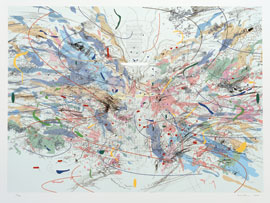Today’s post comes from Kristina Arike, Class of 2014 and Art Center Student Docent.

Friday, April 13, was the opening of the exhibition, “Excavations: The Prints of Julie Mehretu.” The opening lecture, entitled “Julie Mehretu: Migrations,” was presented by Jeanne Greenberg Rohatyn ’89. Rohatyn is a gallerist, art advisor, independent curator, and collector, and even served as a judge during season one of Bravo TV’s “Work of Art.” She is also a collector and dealer of Mehretu’s work, and has a close relationship with the artist. This gives her intimate knowledge of Mehretu’s process, her studio, and her work itself.
Rohatyn began her lecture by discussing Mehretu as an epic storyteller whose work fits into a long lineage of history painting. Her art engages the past, the present, and the future. It also speaks to the history of power and the politics of urbanization.
While paintings and drawings on loan from Rohatyn are included in the exhibition, Mehretu’s prints are the focus, and Rohatyn described them as somewhere in between the immediacy of drawing and the duration of painting. They offer us two distinct visual experiences: that of intimate, close looking and that of a great expanse.
Because of her relationship with Mehretu, Rohatyn was able to offer a look into the artist’s studio. It contains bits and pieces of many cultures that she turns to for inspiration, as well as objects like city maps, architectural drawings, airport maps, street art, and even NFL diagrams. She works with assistants who help her build her canvases up in layers; she often transposes an image on the canvas, and then erases most of it. She repeats this process multiple times. This leaves skeleton images that add spatial depth, as well as a visual history, to the final work.
Her primary palette comes from old maps, yet her work does not behave in the same rational way that a map does. She upends the modernist crutch of the grid; in her work the grid explodes and transforms the historical into the ahistorical. Mehretu also recycles symbols and logos in order to reveal their different meanings. As Rohatyn pointed out, symbols become weapons and markers in Mehretu’s work. The image pictured here, Entropia (review), 2004, was inspired in part by the work of Pop artist Andy Warhol and his paintings of camouflage. Mehretu digitized fabric samples of camouflage from Operation Desert Storm, which we see reflected in the final print.
Rohatyn pointed out that few contemporary painters take on such epic projects as Mehretu, like the 23’ x 80’ mural at the Manhattan headquarters of Goldman Sachs. Even her smaller works, including those hanging in the Art Center galleries, create a sense of breathlessness and invite the viewer to venture within the spaces she creates.
The exhibition is on view at the Frances Lehman Loeb Art Center through June 17, 2012.




